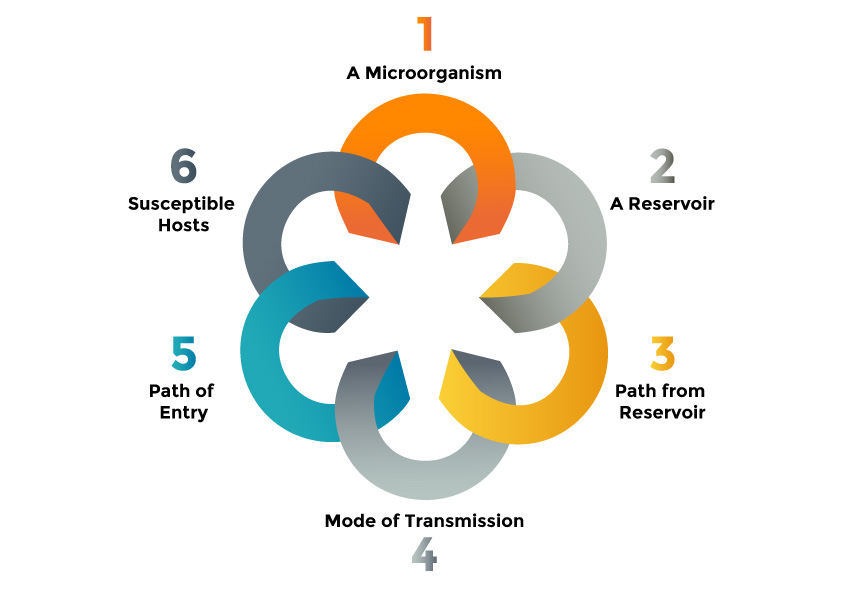
04 May The 6 Links in the Chain of Infection: How Cleaning and Sanitising Plays a Vital Part In the Chain of Infection
Cleaning and sanitising as a distinct two-step process is the key step in effective infection control. in order to understand how cleaning and sanitising is effective, we need to briefly examine how a microorganism migrates to a susceptible host. This migration follows a path (or chain) as shown in the graphic below, and just like any chain, a break in any link will hinder or stop the spread of an infection.
In order to understand and therefore prevent an infectious outbreak, it is essential to understand that an infection requires the following six vital links:
Link 1: A microorganism
Includes bacteria, rickettsiae, viruses, parasites and fungi
Link 2: A reservoir for the microorganism
A place where the microorganism can live. Including surfaces, equipment, static water, inside wet vents, food and water and the human body itself
Link 3: Path from reservoir
The path by which a microorganism leaves its reservoir E.g sneezing, coughing or any bodily secretions.
Link 4: Mode of transmission from person to person
Hand to hand contact with an infected person, hand to surface contact that is contaminated, breathing infected air (airborne), third party agents (vectors) like rodents, flies.
Link 5: Path of entry
The path the microorganism takes as it invades the body. E.g. eating food with poorly washed hands after being in contact with an infectious person results in the ingestion of microorganisms.
Link 6: Susceptible hosts
People with weakened immune systems are more susceptible to disease. This includes people under stress or tired.

Breaking any one of the six links will break the spread of an infection.
In the majority of cases of an infectious outbreak, the primary method of transferring microorganisms (link 3 and 4) from person to person is via hand contact. This is either through direct hand-to-hand contact or hand contact on a contaminated surface. E.g. Poor hand washing after using the toilet and then serving food.
Proper hand washing is the most effective way to prevent the transmission of an infection (link 4): and proper cleaning and sanitising is the most effective way at preventing the harbouring and spread of an infection (link 2 and 3).
While proper handwashing is important to minimise the spread of infection, cleaning and sanitising that renders the surfaces safe by reducing the number of microorganisms and the soiling that provides a home for them, will help prevent cross-infection.
How Cleaning and Sanitising Plays a Vital Part In the Chain of Infection
The two-step cleaning and sanitisation process plays a vital part in infection control – It breaks link 2 by physically removing the reservoir and thereby preventing a safe harbour for microorganisms. The physical cleaning action removes soiling that provides food and safe harbour for microorganisms and rinsing effectively removes the majority of microorganisms themselves. Sanitisers are then applied to the surface to kill off the remaining microorganisms and provide a long-lasting protection to prevent re-colonisation.
It is vital that the cleaning, in the two-step process, is carried out as thorough as possible, making sure that all visible soiling is removed and the surface is rinsed well. If the cleaning is poorly done, the residual soiling and detergents could compromise the efficacy (the performance and efficiency) of the sanitiser.

